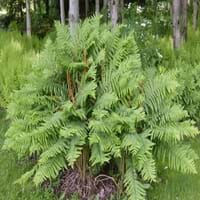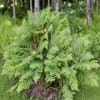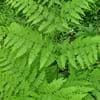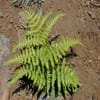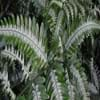Life Span
Perennial
Annual and Perennial
Type
Fern
Bulb or Corm or Tuber
Origin
North America, Caribbean, Eastern Asia
Central America, South America
Types
Not Available
Vine, Flowering plant
Number of Varieties
Not Available
Habitat
Boggy areas, By seashore, Coastal Regions, Moist woods, Swamps
All sorts of environments, Along Railroads, Banks, Moist Ditches, Roadsides, rocky banks of streams
USDA Hardiness Zone
2-10
10-13
Sunset Zone
1a, 1b, 2a, 2b, 3a, 3b, 4, 5, 6
21,22
Habit
Upright/Erect
Vining/Climbing
Minimum Width
Not Available
Flower Color
Yellow Brown
Purple, Rose
Flower Color Modifier
Bicolor
Bicolor
Fruit Color
Light brown
Not Available
Leaf Color in Spring
Green
Purple, Dark Green, Black
Leaf Color in Summer
Green
Light Green
Leaf Color in Fall
Yellow, Green
Several shades of Green
Leaf Color in Winter
Not Available
Light Green
Leaf Shape
Pinnate
Acicular
Plant Season
Spring, Summer, Fall
Spring, Summer, Fall, Winter
Sunlight
Full Sun, Partial shade
Full Sun, Partial Sun
Growth Rate
Fast
Very Fast
Type of Soil
Loam
Clay, Loam, Sand
The pH of Soil
Acidic, Neutral
Acidic, Neutral, Alkaline
Soil Drainage
Average
Well drained
Bloom Time
Not Available
Late Spring, Early Summer, Summer, Late Summer, Early Fall, Fall, Late Fall
Tolerances
Drought, Wet Site
Drought
Where to Plant?
Container, Ground
Container, Ground
How to Plant?
Divison, Spores
Cuttings, Leaf Cutting, Tuber propagation
Plant Maintenance
Medium
Medium
Watering Requirements
Requires a lot of watering, Requires regular watering, Requires watering in the growing season, Water Deeply
Keep the Soil well drained, Needs very little water
In Summer
Lots of watering
Lots of watering
In Spring
Moderate
Moderate
In Winter
Average Water
Average Water
Soil pH
Acidic, Neutral
Acidic, Neutral, Alkaline
Soil Type
Loam
Clay, Loam, Sand
Soil Drainage Capacity
Average
Well drained
Sun Exposure
Full Sun, Partial shade
Full Sun, Partial Sun
Pruning
In late autumn, Remove dead or diseased plant parts
Remove damaged leaves, Remove dead branches, Remove dead leaves
Fertilizers
slow-release fertilizers
All-Purpose Liquid Fertilizer
Pests and Diseases
Insects, Red blotch
Red blotch
Plant Tolerance
Wet Site
Drought
Flower Petal Number
Single
Single
Foliage Texture
Bold
Coarse
Foliage Sheen
Matte
Matte
Attracts
Insects
Aphids, Beetles, Cutworms, Insects, Mites, Whiteflies
Allergy
Avoid during Pregnancy, coma, Eye irritation, weakness
Abdominal pain, allergic reaction, Nausea, Skin rash, Twitching of face
Aesthetic Uses
Beautification, Landscape Designing, Showy Purposes
Not Used For Aesthetic Purpose
Beauty Benefits
Good for skin, Not Available
Not Available
Environmental Uses
Air purification, No fertilizer, pesticides, or herbicides needed, Shelter for wildlife
Air purification
Medicinal Uses
Nutrients
Cures constipation, Fiber, Low calories, lowering blood pressure, Potassium, ß-carotene, Vitamin A, Vitamin C
Part of Plant Used
Leaves
Leaves, Root, Shoots, Stem, Tuber
Other Uses
Air freshner, Decoration Purposes, Employed in herbal medicine, Showy Purposes, Used for its medicinal properties
Starch, Used As Food, Used as Ornamental plant
Used As Indoor Plant
Yes
Sometimes
Used As Outdoor Plant
Yes
Yes
Garden Design
Bog Garden, Edible, Mixed Border, Water Gardens, Wildflower
Container, Edible, Groundcover, Hanging Basket, Herb / Vegetable, Mixed Border, Rock Garden / Wall, Vine
Botanical Name
OSMUNDA cinnamomea
IPOMOEA batatas 'Blackie'
Common Name
Cinnamon Fern
Blackie Sweet Potato Vine, Sweet Potato Vine
In Hindi
दालचीनी फर्न
शकरकन्द
In German
Zimt Farn
Süßkartoffel
In French
Cinnamon Fern
Patate douce
In Spanish
helecho canela
Ipomoea batatas
In Greek
κανέλα Fern
Sweet potato
In Portuguese
Cinnamon Fern
Batata-doce
In Polish
Cynamon Fern
Wilec ziemniaczany
In Latin
Fern cinnamomum
Ipomoea batatas
Phylum
Pteridophyta
Tracheophyta
Class
Polypodiopsida
Magnoliopsida
Order
Osmundales
Solanales
Family
Osmundaceae
Convolvulaceae
Genus
Osmundastrum
Ipomoea
Clade
Not Available
Angiosperms, Asterids, Eudicots
Tribe
Apameini
Not Available
Subfamily
Noctuinae
Not Available
Number of Species
Not Available
Not Available
Importance of Cinnamon Fern and Sweet Potato Vine
Want to have the most appropriate plant for your garden? You might want to know the importance of Cinnamon Fern and Sweet Potato Vine. Basically, these two plants vary in many aspects. Compare Cinnamon Fern and Sweet Potato Vine as they differ in many characteristics such as their life, care, benefits, facts, etc. Every gardener must at least have the slightest clue about the plants he wants to plant in his garden. Compare their benefits, which differ in many ways like facts and uses. The medicinal use of Cinnamon Fern is Nutrients whereas of Sweet Potato Vine is Cures constipation, Fiber, Low calories, lowering blood pressure, Potassium, ß-carotene, Vitamin A and Vitamin C. Cinnamon Fern has beauty benefits as follows: Good for skin and Not Available while Sweet Potato Vine has beauty benefits as follows: Good for skin and Not Available.
Compare Facts of Cinnamon Fern vs Sweet Potato Vine
How to choose the best garden plant for your garden depending upon its facts? Here garden plant comparison will help you to solve this query. Compare the facts of Cinnamon Fern vs Sweet Potato Vine and know which one to choose. As garden plants have benefits and other uses, allergy is also a major drawback of plants for some people. Allergic reactions of Cinnamon Fern are Avoid during Pregnancy, coma, Eye irritation and weakness whereas of Sweet Potato Vine have Abdominal pain, allergic reaction, Nausea, Skin rash and Twitching of face respectively. Having a fruit bearing plant in your garden can be a plus point of your garden. Cinnamon Fern has no showy fruits and Sweet Potato Vine has no showy fruits. Also Cinnamon Fern is not flowering and Sweet Potato Vine is not flowering . You can compare Cinnamon Fern and Sweet Potato Vine facts and facts of other plants too.
